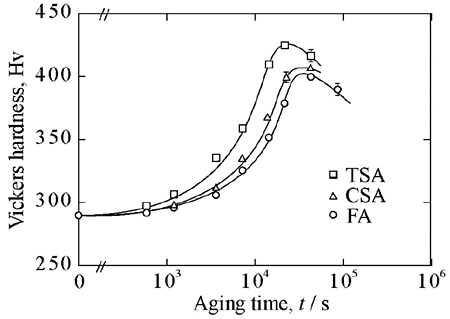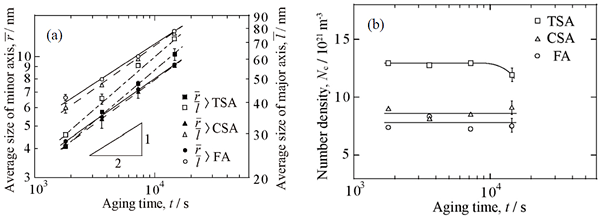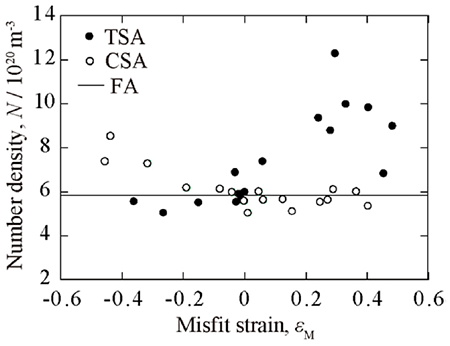The effects of external stress on the nucleation of bar-like α-precipitates were examined for a Ti-20mass%Mo alloy aged at 500 °C. Figure 1 shows Age-hardening curves of Ti-20Mo specimens, tensile-stress-aged (TSA, 400 MPa), compressive-stress- aged (CSA, 400 MPa) and free-aged (FA) at 500 °C. Each age-hardening curve exhibits an increase in hardness from an initial hardness of 290 Hv as increasing aging time. The hardness of each specimen attains peak and then decreases. The hardness of TSA specimens increases more rapidly and attains higher peak-hardness coMPared to the CSA and FA specimens. It should be noted that the compressive stress does not significantly affects the age-hardening behavior. Figures 2 show aging time t dependence of (a) the average sizes of minor and major axes r and l of bar-like α-precipitates and (b) the number density Nc of α-precipitates in Ti–Mo specimens TSA (400 MPa), CSA (400 MPa) and FA at 500 °C.
Figures 2(a) and (b) presents dark-field TEM images of ω-precipitates in two grain in the Ti-20Mo specimens compressive-stress-aged (CSA) and tensile-stress-aged (TSA) under 500 MPa at 300 °C for 9 h after being free-aged (FA) at 300 °C for 3 h. It can be seen in Fig. 2(a) that linear relationships exist between log r or log l, and log t for each specimens, i.e. r ∝ tn or l ∝ tn. The values of n are calculated from the slopes of the straight lines obtained by the least-squares method. For CSA and FA specimens, the values of n were approximately 1/2. An n-value of 1/2 indicates that the growth kinetics of the α-precipitates follows a diffusion-controlled parabolic growth law. Whereas for TSA specimen, n > 1/2. This indicates that the growth of the α-precipitates was accelerated by a tensile stress. In Fig. 2(b), the values of Nc is almost constant from 0.5 to 4 h. This means that nucleation of α-precipitates was completed in at least 0.5 h in each specimen. The values of Nc of the TSA specimen is higher than that of the FA sample. Therefore, it can be understood that the tensile stress promotes nucleation of α-precipitates. On the other hand, the values of Nc of the CSA specimen is only slightly higher than that of the FA specimens, and it can be said that compressive stress has not significantly affected on the nucleation of α-precipitates.
Average misfit strains ![]() and
and ![]() of α-precipitates along the loading direction LD and transverse direction TD were estimated by the combination of lattice constant of β-Ti matrix and length change measurements for Ti–Mo specimens, TSA at 500 °C for 0.5 h and FA at 500 °C for 24 h (TSA–FA’) and CSA at 500 °C for 0.5 h and FA at 500 °C for 24 h (CSA–FA’), and average misfit strain
of α-precipitates along the loading direction LD and transverse direction TD were estimated by the combination of lattice constant of β-Ti matrix and length change measurements for Ti–Mo specimens, TSA at 500 °C for 0.5 h and FA at 500 °C for 24 h (TSA–FA’) and CSA at 500 °C for 0.5 h and FA at 500 °C for 24 h (CSA–FA’), and average misfit strain ![]() for a specimen, FA at 500 °C for 0.5 h and FA at 500 °C for 24 h (FA–FA’). The value of
for a specimen, FA at 500 °C for 0.5 h and FA at 500 °C for 24 h (FA–FA’). The value of ![]() was estimated as 0.019. Figure 3 exemplifies the number density N of α-variants in Ti-Mo specimens, TSA, CSA and FA at 500 °C for 4 h as a function of the misfit strain εM of the variants along the loading direction LD. The tensile stress promotes the formation of α-precipitates when the misfit strain εM of the precipitates along the loading direction is greater than 0; however, it does not significantly affect the precipitate nucleation in case where εM < 0. In contrast, the compressive stress promotes the precipitate nucleation when εM < 0 and does not significantly influence it when εM > 0.
was estimated as 0.019. Figure 3 exemplifies the number density N of α-variants in Ti-Mo specimens, TSA, CSA and FA at 500 °C for 4 h as a function of the misfit strain εM of the variants along the loading direction LD. The tensile stress promotes the formation of α-precipitates when the misfit strain εM of the precipitates along the loading direction is greater than 0; however, it does not significantly affect the precipitate nucleation in case where εM < 0. In contrast, the compressive stress promotes the precipitate nucleation when εM < 0 and does not significantly influence it when εM > 0.


